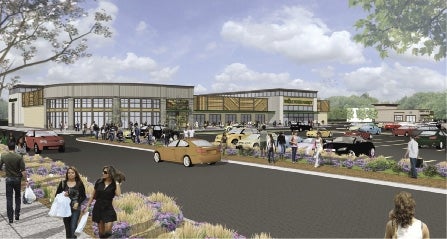When Grossman Development Group LLC, the force behind a mixed-use project at the site of the former Spag’s in Shrewsbury, officially signed two new commercial tenants earlier this month, President Howard Grossman said one factor drove their interest.
“As soon as they hear that Whole Foods is your anchor tenant they know, number one, the number of customers, and also the quality of customers,” he said.
The Whole Foods location set to open next year in Shrewsbury will supplement its existing Central Massachusetts locations in Wayland, Framingham and Bellingham. Like Wegmans’ choice of Northborough for its first New England store in 2011, the planned Whole Foods store signals something more than just another place for local customers to buy milk and eggs. For years, observers have noted something called the “Whole Foods effect”: when the high-end grocer moves into a neighborhood, local real estate values tend to rise. It’s not clear that this is really a matter of cause and effect, or that it applies at all beyond the dense urban neighborhoods where many Whole Foods stores are located. Still, the arrival of the store, along with a number of other retail and restaurant establishments in Shrewsbury and elsewhere in Central Massachusetts, does reflect some changing dynamics in the region.
Susan Strate, a demographics expert with the UMass Donahue Institute, said that after experiencing slow population growth relative to the rest of the country in the early years of the new century, Massachusetts is seeing healthy growth today.
“The state as a whole has been growing quite rapidly in the last four years as compared to the decade before,” Strate said. “The central region is part of that, though certainly not as far ahead as Boston.”
Favorable demographic trends
With the cluster of colleges in and around Worcester, Strate said Central Massachusetts is a strong area for young adults. New graduates tend to head elsewhere, but many people in their late 20s and early 30s move back into the region.
“I would say that if you were a business looking to be around an area where you have families and young people then the central area certainly is rich,” Strate said. “It does appear to be an attractive place to raise your family.”
Strate said that in recent decades population growth has been particularly strong in Shrewsbury itself, shooting up 31 percent between 1990 and 2000, when the entire state was in growth mode. From 2000 to 2010, the state grew only 3.1 percent, but Shrewsbury continued to add residents at a decent clip, growing 13 percent.
But will a Whole Foods bring more people to town? John Demac, an owner of Collins & Demac Real Estate in Shrewsbury, doesn’t think so.
“People don’t buy into a town because of the Whole Foods,” he said. “It’s the town government, it’s the schools.”
But Demac said he does see interest in the store among the growing population. “From the demographics, there’s definitely a need,” he said. “I know I would definitely shop at Whole Foods.”
Whole Foods wouldn’t be moving into Shrewsbury if there wasn’t a good market for the store there, just as Wegmans wouldn’t have opened in Northborough without good reason, said Alida Destrempe, a senior analyst for the grocery market with Kantar Retail.
“Both those retailers don’t roll out their stores unless they know that those stores can be successful,” she said.
But Destrempe said Whole Foods’ arrival in a town doesn’t necessarily signal that the area is becoming a mecca for people with more disposable income to spend on perfect organic blueberries. “It does have that ‘whole paycheck’ persona, but they have been growing their private label, with a lower price point,” she said.
How does it play in Detroit?
Notably, Whole Foods opened a store in Detroit in 2013, and Destrempe said it seems to be proving fairly successful.
Part of what the chain’s new location may signal is simply that the company has big ambitions for growth. Destrempe noted that in recent years the grocery store market has been splitting down the middle, with premium and value-driven stores both on the rise while middle-of-the-road chains struggle to keep up.
In a recent presentation to investors, Jim Sud, Whole Foods’ executive vice president of growth and business development, noted that the company plans to grow from its current 411 stores to 500 by the end of 2017. The company sees a potential market for 1,200 locations or more. Sud said the chain is now opening stores in small markets that it would “never have considered even five years ago,” and also packing stores more closely together in urban markets. That reflects an overall growth in the market for healthy food, as well as greater recognition of the Whole Foods brand, Sud said.
Grossman, the Spag’s site developer, said the site was an obvious one for the chain. The large property, highway access and dense local population were all draws.
More generally, Grossman said, it seems clear that the region is ripe for continuing development in the future, and Whole Foods won’t be the only one taking advantage of it. “My company’s made a commitment to the Worcester County area to do more,” he said. “We feel this is an area that’s growing, that could use more good development.”

